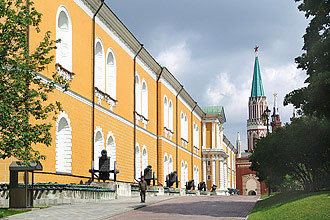Opened 1828 Function Arsenal Current tenant Kremlin Regiment | Completed 1828 Construction started 1702 | |
 | ||
Similar Moscow Kremlin, Kremlin Senate, Church of the Twelve Apostles, Troitskaya Tower, Church of the Depositio | ||
The Kremlin Arsenal (Russian: Арсенал Московского Кремля) is a former armory built within the grounds of the Moscow Kremlin in Russia. Initially constructed in 1736, it has been rebuilt several times. It remains in military use to date, unlike the Kremlin Armoury, another arsenal within the walls of the Moscow Kremlin, which is now a museum. The building is off-limits to tourists, who can view a portion of its short southern façade upon entering the precincts of the Moscow Kremlin.
Contents
Map of Kremlin Arsenal, Moskva, Russia, 109012
The Kremlin Arsenal is currently home to the Kremlin Regiment, which forms the main security service for the Russian President, and the longer eastern façade is a high secured and restricted area closed to the public.
Building
The Kremlin Arsenal is a large elongated trapezoid two-story building with a large courtyard. It occupies most of the northern corner of the Moscow Kremlin, with its north-west and north-eastern sides directly adjacent to the Kremlin Wall parallel to Red Square, from Trinity Tower to St Nicholas Tower.
The two-story building is 24 metres (79 ft) high and 300 metres (980 ft) long on its longest side. Its brick walls are painted yellow, as are most other official buildings within the Kremlin. Of note are its two rows of spaced paired arched windows with deep white limestone frames. Two entrances to the patio on the south and east facades have arched porticos with baroque ornaments.
History
In the Middle Ages, the spot was occupied by granaries. After they burnt down in the last years of the 17th century, Peter the Great engaged a team of Russian and German architects to construct the Kremlin Arsenal, designed to be one of the largest buildings in Moscow at the time. Construction started in 1702, but was interrupted due to lack of funds during the Great Northern War with Sweden, and was only completed in 1736, under supervision of Field-Marshal Burkhard Christoph von Münnich. The new building was gutted by a fire in 1737, and only restored from 1786-1796.
During Napoleon's invasion of Russia, the retreating French soldiers had the central part of the building blown up. It was restored between 1816 and 1828 to a Neoclassical design in order to house a museum dedicated to the Russian victory over Napoleon.
Accordingly, some 875 cannons captured from the retreating Grand Army were put on display along the south walls of the Arsenal. Of these, 365 are French, 189 are Austrian, 123 are Prussian, 70 are Italian, 40 are Neapolitan, 34 are Bavarian, and 22 are Dutch. Since 1960, Russian carriage-mounted cannons of the 16th and 17th centuries have been displayed along the south wall of the building.
